Flying Blind: The crash of Invicta International Airways flight 435
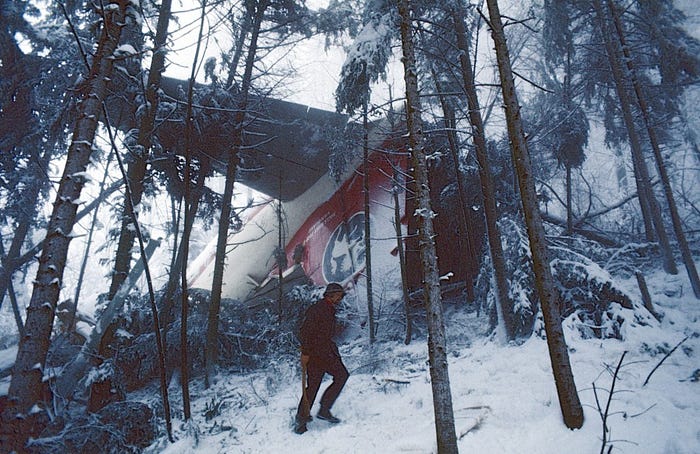
On the 10th of April 1973, a British charter flight bound for Switzerland strayed off course while on approach to Basel during a snowstorm. The plane flew in a series of disjointed loops around the airport as air traffic controllers struggled to figure out where it was and where it was going, even as its pilots insisted that they were on course and would soon land. But just a few minutes later, the plane crashed into a snow-covered hillside in the Jura Mountains, destroying the aircraft and killing 108 of the 145 people on board. Thirty-seven survivors huddled together and chanted hymns to stave off the cold, before at last being rescued. But how had the flight become so hopelessly lost in the first place? Why did it crash into a hill far beyond the airport, while flying away from the runway that the pilots thought they were landing on? Due to a frustrating lack of information, not every question could be answered, but investigators did piece together most of the baffling chain of events that led to Switzerland’s deadliest air disaster.
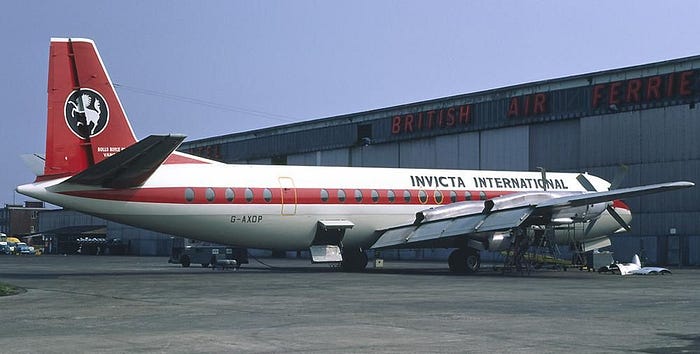
In April of 1973, a collection of women’s groups from the Somerset villages of Axbridge, Cheddar, Yatton, Wrington, and Congresbury excitedly prepared for their third annual organized trip to Switzerland. Among the social groups planning to participate were the Axbridge Ladies Guild, the Axbridge Ladies Evening Out group, the Cheddar Mum’s Night Out group, and skittles teams from Wrington and Congresbury, as well as numerous friends and relatives of the members. This year, they planned to fly to the city of Basel, on the border between France, Switzerland, and Germany, for a shopping trip. Pooling their money, the various clubs and guilds were able to charter their own plane for the journey, and they intended to fill it to capacity.
To hire a plane big enough for everyone, the group turned to Invicta International Airlines, a charter airline founded in 1964 and based out of Manston Airport in Kent. Invicta provided the largest airplane it had, a four-engine turboprop Vickers Vanguard built in the early 1960s. An aeronautical afterthought, the Vanguard first flew in January 1959 and was immediately made obsolete by the introduction of new jet airliners later that same year. As a result, only 44 were built, several of which had been acquired by Invicta from Trans Canada Airlines. The hulking Vanguard had room for 139 passengers, and the groups ultimately filled the entire plane, after offering up the leftover seats to their friends, husbands, children, and other guests.

On the 10th of April, the big day arrived, and the passengers got up early to board the plane on the apron at Lulsgate Airport in Bristol. In addition to the 139 passengers, most of whom were women, six crew arrived with the plane, including four stewardesses and two pilots. At the controls that day were two captains, Anthony Dorman and Ivor Terry. Terry was the senior of the two, but since he had flown the positioning flight to Bristol, Dorman would fly the next segment to Basel, as it was customary to swap roles after each leg when two pilots of the same rank occupied the flight deck. Terry was by all accounts a competent pilot, but the same could not be said of Dorman. Anthony Dorman, a Canadian, initially tried to get his wings in the Royal Canadian Air Force, but in 1963 his training was ended because he displayed “insufficient aptitude for flying.” Over the next several years, he first acquired a private pilot’s license, then worked his way up to a senior commercial pilot’s license, and finally received a Nigerian pilot’s license, although no evidence of the completion of the test flight for this license could be found. Between 1970 and 1971, he tried eight times to acquire a United Kingdom instrument rating — the qualification that would allow him to fly at night and in clouds — but failed each time, finally succeeding on the ninth attempt. Instructors wrote that he possessed “inadequate flying and/or theoretical knowledge.” He subsequently acquired the requisite certificates to fly the Douglas DC-3, Douglas DC-4, and Vickers Vanguard, but required multiple attempts for each. Clearly, Dorman was someone who was passionate about flying — one must be, in order to try again after so many failures — but he displayed an almost complete lack of talent for his chosen profession.

At 7:19 a.m., Invicta International Airlines flight 435 departed Bristol and headed south toward Switzerland. But despite the late date, the weather in Basel was positively wintry, with a heavy snowstorm blanketing the entire region. By the time flight 435 drew near its destination shortly before 9:00 a.m., the pilots were well aware of the weather situation, and were presumably prepared for the worst.
The Swiss city of Basel, the French city of Mulhouse, and the German city of Freiburg are all served by Basel-Mulhouse-Freiburg Airport, located in French territory less than three kilometers from the Swiss border. Flight 435 planned to approach this airport from the north to land on runway 16 using the instrument landing system, the equipment that sends out signals that the plane can follow down to the runway threshold. But first, they needed to navigate to the right spot to pick up the signal. The normal starting point for the approach was at a radio beacon called BN, located a few kilometers north of the airport on the extended centerline of runway 16. Known as a Non-Directional Beacon, or NDB, BN could be detected by the airplane’s Automatic Direction Finders (ADFs), a pair of instruments on board that plane that can track various radio beacons to help pilots navigate. At 8:49, flight 435 contacted Basel air traffic control and estimated that they would arrive over BN at 8:55. The controller acknowledged the transmission and passed on the weather report: wind 360 degrees at 9 knots, visibility 700 meters in falling snow.
The approach plan for runway 16 was to fly to BN, then make a left-hand loop via another NDB called MN before coming back around to BN from the north, in line with the runway. By tracking BN on one ADF and MN on the other, the pilots should have been able to follow this loop quite easily. But at Basel, it wasn’t so simple. All the NDBs in the vicinity of Basel deviated from the standards set by the International Civil Aviation Organization (ICAO), because they produced an unmodulated signal that was harder to identify, a problem which was exacerbated by the weather and by intermittent electrical interruptions in Captain Dorman’s ADF. It was still possible to track the beacons using this ADF, but cross-checking with other instruments would be necessary to ensure that they were on the right course.

As soon as the pilots of flight 435 began tracking BN and MN to try to execute this turn, the flight path became extremely unstable. There were large fluctuations in altitude and airspeed that were suggestive of a pilot who was not paying sufficient attention to flying the plane. And after intercepting BN, they turned too sharply, causing the flight to undershoot MN by a significant margin. At 8:57, Captain Terry, who was handling the radio calls, reported that they were over MN, although they were actually passing abeam the beacon a few kilometers distant. The controller, whose radar was unreliable at that distance in falling snow, had no reason to believe that the pilots were anywhere other than where they claimed to be, and he cleared flight 435 to approach runway 16, asking them to report passing over BN on the descent.

Because the initial turn onto the loop had been too sharp, when flight 435 turned back to the left toward BN, it was not lined up with the runway. Therefore, they would have to try the loop again after reaching BN. “435 is BN, turning outbound again, will call MN,” Terry told the controller. But the pilots seemed to believe that BN was MN, and that another beacon, BS, was BN. After passing over BN, they executed an extremely steep 270-degree turn straight back to BN, instead of proceeding to MN. The turn was so steep that they lost 950 feet of altitude, and when they finally leveled off, they did so on a course considerably to the right of the runway heading. They never did report passing MN, as they had promised the controller.
From this point, Terry and Dorman needed to navigate to the runway using the instrument landing system. A beacon at the airport, known as the localizer, emits a narrow beam along the extended centerline of the runway, which is picked up by the plane’s ILS receiver and displayed on the Course Deviation Indicator (CDI). The localizer needle on the CDI would sit in the midpoint of the gauge if the plane was on the localizer beam, and would deviate to one side or the other if the plane moved off the beam, thus allowing the pilots to follow the localizer to the runway by keeping the needle in the center (see diagram below). However, the captain’s side CDI on this plane was faulty. Just the previous day, a crew who flew this plane noticed during an approach that the captain’s CDI showed them on course while the first officer’s showed them deviating significantly to the left of the localizer. After catching sight of the runway, the crew confirmed that the copilot’s instrument was correct and they were indeed well to the left of the localizer. The crew didn’t leave a note about this problem in the aircraft’s technical log, but claimed they told a mechanic, who denied that this took place. Regardless of the specifics, the problem had not been rectified by the time flight 435 took off. As the crew attempted to line up with the runway at Basel, Captain Dorman was flying from the left seat with the faulty CDI. It is thought that when he attempted to get back on the localizer after overshooting to the right, his CDI likely indicated that they were farther to the right than they actually were, and in his attempt to intercept it, he flew farther to the left than was necessary, passing straight through the localizer beam. Now his CDI showed him on course, while Terry’s would have (correctly) shown that they were too far to the left, but for whatever reason this discrepancy was not noticed or did not result in a course correction.

But that was only half the problem. The non-directional beacon BS, which the pilots mistakenly believed was BN, was located on the opposite side of the airport. After flying straight past the airport, they passed abeam BS, but reported to the controller that they were over BN. The controller then cleared flight 435 to land on runway 16, which was by this point behind them. As flight 435 drew near the ground, it was actually over the city of Basel, giving passengers a disturbing view of the neighborhoods below through the blowing snow. After narrowly avoiding several buildings atop a hill, the crew must have realized that they were not where they thought they were. Captain Dorman pulled up to climb, and Terry said to the controller, “435 is overshooting!”

Moments later, the control tower at Basel Airport received a phone call from a concerned citizen who had witnessed the plane’s low pass over the city. “Yes, good morning Monsieur,” said the man. “This is Beck at the Basel-Binningen Observatory…”
“Yes?”
“There is an aircraft which has just passed two minutes ago headed south, ah, probably a four-engine turboprop, and it is flying at barely 50 meters, and then it is snowing very heavily, and I have the impression if it remains like this, it will crash in the mountains.”
“Ah, hold on,” said the tower controller, “you are really sure that it’s flying at 50 meters?”
“Yes, certainly,” said Beck. “I was a pilot with Swissair, I have just — I have now retired.”
“Ah, agreed.”
“I work here at […]. I am telephoning you, it was here, at a maximum of 50 meters, south of the Observatory here.”
“Right, thank you.”
“It had a red tail unit, I could not — I did not have time to see the markings.”
“Yes but… there is an aircraft which has just overshot there which is going to return over […]”
“It must be made to climb,” said Beck.
“Yes, agreed, thank you.”
“It must be made to climb, it is going to crash in the mountains like this!” he repeated.
The controller again agreed, Beck thanked him, and the call ended. But nobody ever instructed flight 435 to climb.
Meanwhile on board the plane, Captain Terry decided to take over for Captain Dorman, perhaps because he was beginning to lose confidence in his fellow pilot’s judgment, or because they had discovered the problem with Dorman’s ILS display. Although Terry was much better able to maintain altitude and airspeed, he was no less confused about their location than Dorman had been. He took the plane around another 360 degree loop toward BS, but upon reaching it, reported passing MN. The controller asked them to report BN on final, and Dorman replied, “Roger.”
After passing over BS, Terry initiated a U-turn back to the left, swooping over the airport and back past BS, until they reached the extended centerline of runway 34 (runway 16 in the opposite direction). At this point, flight 435 intercepted what is called the “back beam” of the localizer for runway 16. A localizer beacon not only sends out a signal toward incoming aircraft, but also an inverse signal known as the back beam that continues in an equally narrow band in the opposite direction.

Occasionally, a back beam may be deliberately tracked in order to land on a runway without ILS by using the ILS belonging to the reciprocal runway; however, for runways 16 and 34 no such procedure existed, and the pilots clearly did not know that they were intercepting the back beam and not the real localizer. If one attempts to follow the back beam the same way the localizer would be followed normally, one will end up flying away from the airport instead of toward it. Consequently, they began following the back beam south, away from Basel and into the mountains.

At this point, another faulty instrument caused a coincidence that sealed the fate of everyone on board. Besides the localizer, an instrument landing system also includes a glide slope. While the localizer is used to track the plane’s lateral position relative to the approach path, the glide slope is used to track the vertical position, ensuring that the plane is coming in at the correct angle. When flight 435 flew to the south of the airport, it began to pass out of range of the glide slope signal for runway 16, which should have caused a red “fault” flag to appear on the CDI. However, on the first officer’s side CDI the flag had been calibrated incorrectly, causing it not to appear even if the signal was unsatisfactory. Coincidentally, when the signal was weak or unreadable, the needle would default to the midpoint on the CDI, which also corresponded to the position it would take up if the plane was on the glide slope. Therefore, to Captain Terry, who was sitting in the first officer’s seat, it would have seemed as though his instruments showed them on the correct glide slope, even though they were not. Captain Dorman’s glide slope receiver would have shown a red warning flag indicating that it was not picking up the signal, but apparently no one checked it. The stage was now set for disaster: the plane was descending away from the airport and toward the Jura Mountains, but Captain Terry’s instruments appeared to indicate that they were lined up with the runway.

Shortly thereafter, a controller in the Zurich regional control center spotted flight 435 on radar heading south at low altitude. The Zurich controller called the Basel controller and said, “Tell me you have someone who has taken off who is now crawling towards Hochwald?”
“Ah! Who is on the Hochwald side?” the Basel controller asked. “We have an aircraft which has overshot, yes, but it is going to return to BN.”
“Ah, it is…” said Zurich.
“Hold on, hold on,” said Basel.
“It has a heading for Hochwald.”
“What?”
The Basel controller momentarily interrupted the conversation to clear flight 435 to land.
“It has a heading for Hochwald,” Zurich repeated.
“Towards Hochwald, hold on…”
“What is its flight level?” Zurich asked.
As a precaution, the Basel controller scanned his radar screen for any sign of the plane, and to his surprise there was a faint echo heading south into the Hochwald area. “Ah!” he exclaimed. “I see one in that direction which is heading for Hochwald now, you will be told that at once… Yes, hello, you must check with Paris because the aircraft has supposedly passed BN, it has just contacted us, ours has passed BN…”
“It is probably a VFR but that’s not on now,” said Zurich, suggesting that the radar echo belonged to a small private plane that was not supposed to be out in this weather.
To be sure, the Basel controller called flight 435 and asked, “Are you sure you are over BN?”
“I think I’ve got a spurious indication,” Dorman replied. “We are on the lo…we are on the ILS now, sir.”
“Ah!”
“BN is established on the localizer and glide path, the ADFs are all over the place in this weather,” Dorman continued.
“For information, I don’t see you on my scope radar,” said the controller. “What is your altitude now?”
“One thousand four hundred,” said Dorman.
“I think you are on the south of the field, you are not on the… you are on the south of the field,” said the controller. But there was no reply from flight 435. The controller tried a further 38 times to contact the plane, but it was never heard from again.
At that moment, Captain Terry initiated an immediate go-around, probably due to the controller’s transmission. But through the snow they could not see that there was an extremely steep mountainside looming ahead of them, and they had no way of knowing that they were not climbing fast enough to avoid it. Seconds later, the plane clipped trees at the top of a ridge, rolled inverted, and plowed upside down into the edge of a snow-covered field, sending burning pieces of the shattered fuselage cartwheeling through the forest.

Although the front of the plane was destroyed on impact and everyone seated there died instantly, the tail section remained intact, coming to rest on its roof in the snowbound forest. Inside, a number of passengers and two flight attendants had miraculously survived the crash. People unbuckled their seat belts and immediately fell down to the roof, which had become the floor. Slowly, they made their way out into a bleak, white world. Almost a meter of snow blanketed the ground, and more had already begun to bury the aircraft wreckage, casting a pall of silence over the grisly scene.
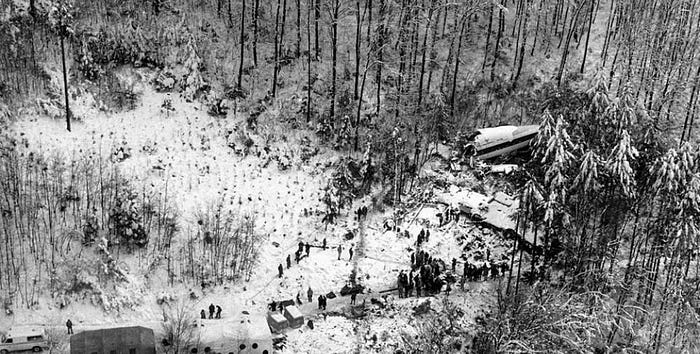
As the survivors sat amid the snow waiting for rescue, the possibility of hypothermia was ever-present. Some of those with only minor injuries set about trying to find more survivors from other parts of the plane, but across the vast wreckage field, they succeeded only in finding bodies. Two men, one with a broken leg, set out to find help, while the remaining survivors, most of them women, huddled around the tail and sang hymns to keep up their spirits.
Meanwhile, rescuers struggled to find the crash site. An early report of a possible crash never made it to the proper authorities, and the heavy snowfall limited travel on nearby roads to all-terrain vehicles only. The first to find the wreck was not a firefighter, but a 10-year-old farm boy out on a walk who stumbled across the scene. He led the survivors back to his house, where they were able to warm up while waiting for rescue. Emergency services from the nearby town of Hochwald, alerted by the family to the discovery of the crash site, soon arrived and those who had been injured were rushed to hospital. In all, 37 of the 145 people on board survived the crash, while 108 perished, making Invicta International Airlines flight 435 the deadliest plane crash on the territory of Switzerland, a title that it holds to this day. Of the 108 victims, 89 were women, and due to the types of groups on board, most of them were also mothers. They left behind no less than 55 orphaned children.
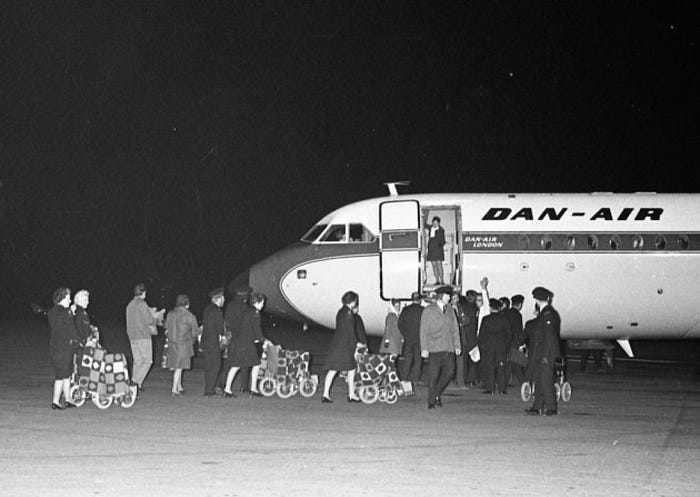
The affected Somerset communities were utterly devastated. Entire families had been wiped out in the crash, with only a few individuals left to grieve for those who had died. One woman who had stayed behind lost an incomprehensible eleven members of her family. For some, it took days to find out whether their loved ones had survived, as communication from Switzerland was extremely spotty. The BBC gave extensive coverage to the setting up of a grief counseling service, but years later, most of the relatives of the victims reported that they never received nor were offered any counseling, and were left to deal with the terrible loss on their own.
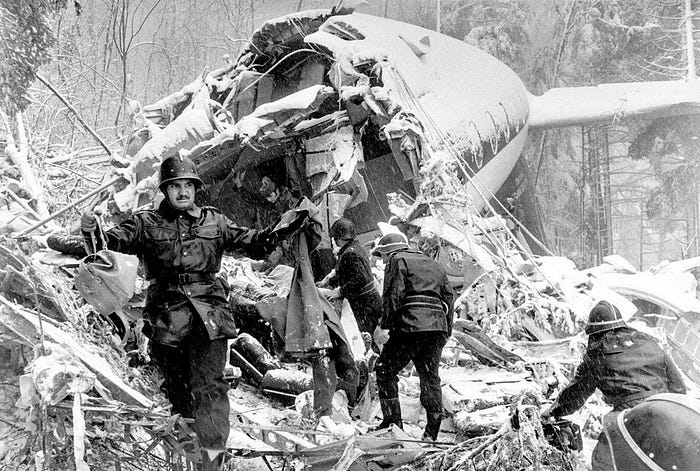
Meanwhile, Swiss and British investigators began trying to figure out why flight 435 crashed so far from the airport, while supposedly approaching runway 16. Their efforts were severely hampered due to the fact that the Vickers Vanguard had no cockpit voice recorder, and under British law at the time it was not required to carry one. But the plane was equipped with a flight data recorder, from which the investigation was able to derive the course of the flight, and it immediately became apparent that the location of the plane throughout the two approaches did not correspond to where the pilots reported it to be. In fact, flight 435 followed a bizarre and circuitous flight path that at first seemed to have no correlation to any sensible approach pattern.
But as the investigators looked deeper into the status of the plane’s instruments and the condition of the non-directional beacons near Basel, the flight path started to make some sense. Beginning after the first botched loop, the pilots began to confuse the NDBs, which was possible because they produced unmodulated signals. Unlike a modulated signal, which includes identification information, an unmodulated signal can only be identified by the frequency at which it transmits. But if the automatic direction finders (ADFs) being used to track the NDBs were not sufficiently precise, it could be difficult to tell exactly which unmodulated beacon was actually being tracked. In fact, a poorly soldered joint in the captain’s side ADF caused intermittent electrical interruptions, and the falling snow introduced static in the signals, which probably combined to make the ADF readings somewhat erratic. The pilots would have had to periodically crosscheck the ADF reading against other parameters, such as heading, but investigators could only conclude that they did not do this. French authorities also defended the use of unmodulated signals on NDBs, despite the difficulty this caused for pilots, because the practice allowed more beacons to be installed in the allotted frequency band.

Further complicating the approach was the faulty Course Deviation Indicator on the captain’s side, which led the flight astray on its first landing attempt. Once again, a cross-check against the first officer’s CDI in combination with the aircraft heading could have revealed the problem. And during the second approach, when a faulty glide slope receiver made it seem as though they were on course, a cross-check again could have revealed that the other identical instrument did not agree. Investigators were frustrated by the pilots’ failure to perform instrument cross-checks, as well as the absence of a cockpit voice recording that might have explained why they never did so. They did speculate, however, that having two captains on the flight deck eroded the authority gradient and caused them to overlook duties normally assigned to the first officer. For much of the flight, the senior Captain Terry was acting as first officer, and he was certainly not used to the role.
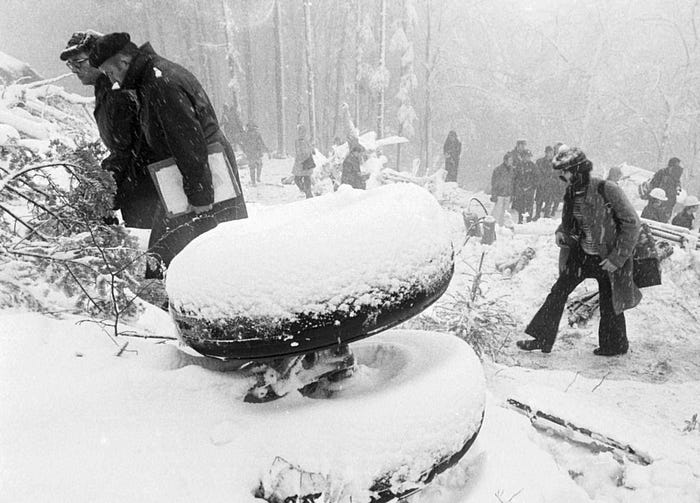
Although the investigation ultimately stated that the probable cause of the accident was a loss of orientation due to a failure to cross-check the instruments, there were significant operational problems that had made the pilots’ job much harder. The fact that so many instruments were faulty was indicative of poor maintenance practices at Invicta International Airlines, but despite evidence of botched repairs on the ILS and ADF equipment, investigators could find no record of any repairs having been carried out on these instruments. Nor was there any evidence that Invicta had attempted to find the cause of instrumentation errors reported by crews over the months and years leading up to the crash. In summarizing the state of the plane’s maintenance, Swiss investigators wrote, “It is doubtful whether the maintenance and repairs to [its] radionavigational equipment fulfilled the conditions for commercial IFR [instrument flight rules] operations.” They further added that given the state of the equipment, “the safety of ILS approaches was doubtful.”
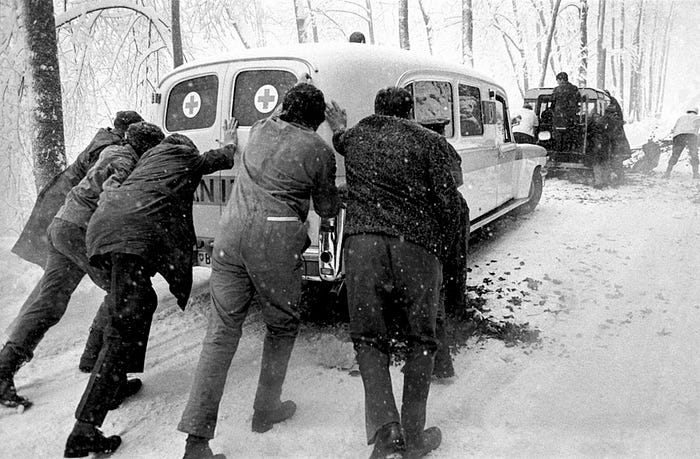
By the time all was said and done, some questions remained. It will never be known for sure why neither pilot figured out their real position, why no one suggested climbing to a safe altitude and proceeding to a known waypoint, or how they began to confuse the NDBs in the first place. Considerable additional depth could have been added to the story if the plane had a cockpit voice recorder, and as such, the investigators recommended that all British aircraft over 5,700 kilograms be required to carry one, reiterating a recommendation issued by British investigators after the crash of BEA flight 548 the previous year. But what we do have is a basic understanding of why things went wrong, even if the specifics are unknown. Captain Dorman had failed his instrument rating examinations eight times, suggesting that he was not competent at flying in bad weather when he couldn’t see outside the plane. With confusing instrument readings and unreliable NDBs, it was no surprise that he became hopelessly confused. By the time Captain Terry took over for his overwhelmed copilot, it was far too late to salvage the situation.
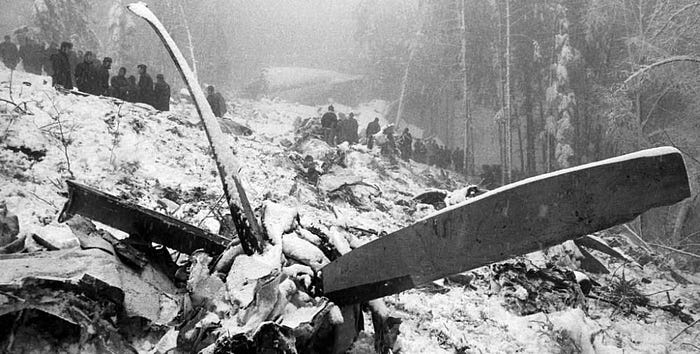
In addition to the aforementioned note about CVRs, the investigators also recommended that Basel Airport provide radar guidance to inbound aircraft; that the radio beacons in the Basel area emit modulated signals as required by ICAO; that unpublished ILS back beams be suppressed; that approach charts contain information to help pilots cross-check their location relative to nearby radionavigational aids; and that all aircraft over 5,700 kilograms be equipped with a ground proximity warning system. Today, all of these improvements have been implemented in one way or another, mostly in response to patterns of crashes rather than due to this particular accident. It can be said with confidence that such an accident would not happen today, although this provides little comfort to the handful of English villages that, 47 years later, are still grappling with the simultaneous loss of so many members of their tight-knit communities.
________________________________________________________________
Join the discussion of this article on Reddit!
Visit r/admiralcloudberg to read over 140 similar articles.
You can also support me on Patreon.
